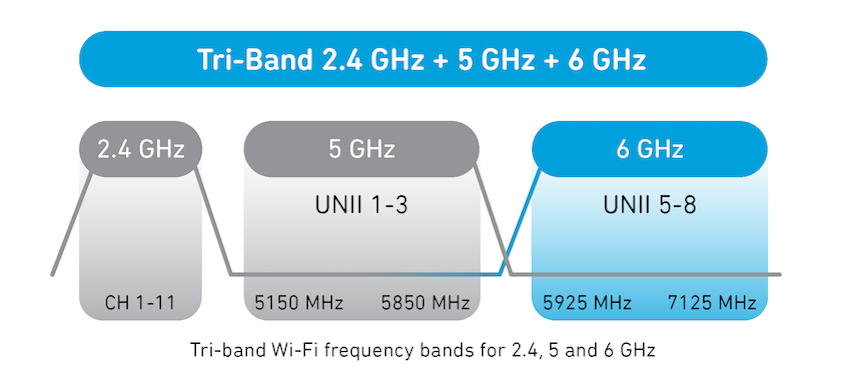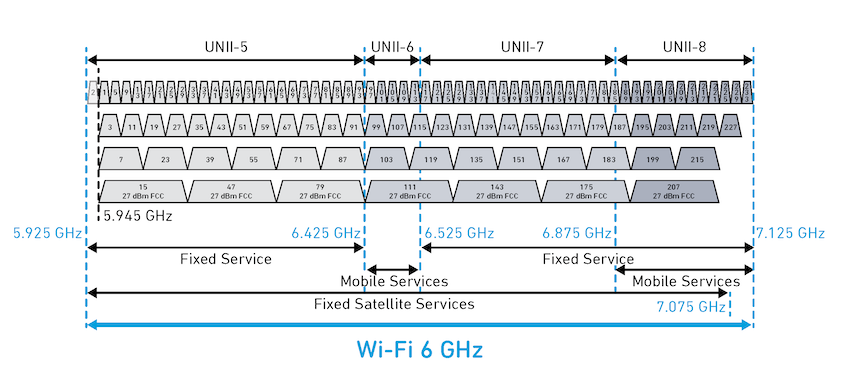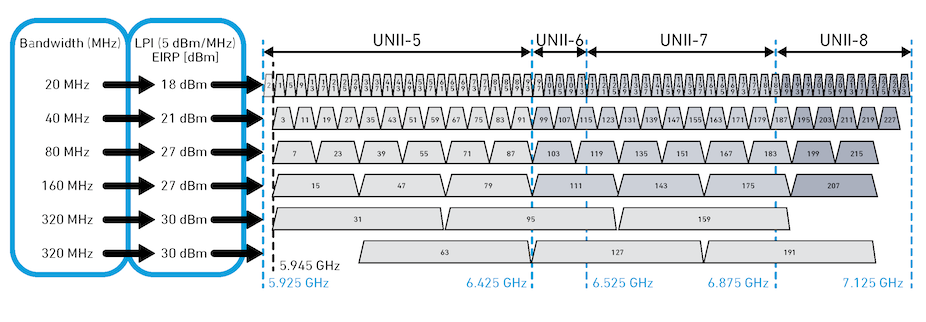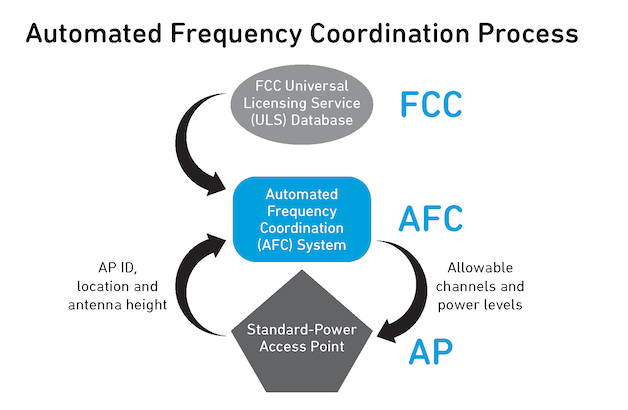Exploring Automated Frequency Coordination (AFC) in the Wi-Fi 6GHz Realm
January 2, 2024
Wi-Fi 6E/7 tri-band will bring additional bandwidth of 1200 MHz, opening the door for gateways capable of gigabit speeds. However, this additional bandwidth will require some added coexistence measures to work in certain environments. This 6 GHz band already has licensed operational fixed, common carrier, local television transmission, broadcast auxiliary and cable television relay services operating within this same bandwidth. Therefore, some higher-level spectrum coexistence measures are required.

Below we will explore the implications this will cause and how the Federal Communications Commission (FCC) is approaching resolutions to help ensure a fair and cohesive alignment for Wi-Fi and other licensed and unlicensed radios to coexist in the United States.
6 GHz band Incumbent Licensed Players
As noted, there are several incumbent players in the 6 GHz bands, as shown in the image below – fixed wireless, fixed-satellite and mobile. These incumbent users have paid licensing fees in order to operate in this band, therefore the FCC must take steps to protect their investment. Wi-Fi 6e and Wi-Fi 7 encompass the entire U-NII-5 to U-NII-8 spectrum; therefore, in areas where incumbent radio signals reside – some requirements are needed to ensure coexistence. This is where AFC comes into play.

To protect these incumbent fixed microwave operations in the 6 GHz bands, unlicensed devices above the power levels defined by low power indoor (LPI) and any outdoor device will only be permitted access to the spectrum under the control of an AFC system. This will help mitigate interference with incumbent services as well as increase the needed spectrum for unlicensed innovative use.
The FCC and 6 GHz Band Ruling
In April 2020, the FCC voted unanimously to adopt new rules for wireless operation in the 6 GHz band, which opened 1200 MHz of spectrum to unlicensed devices like Wi-Fi access points (AP). This decision tripled the available bandwidth for Wi-Fi, allowing more spectrum for backhaul, gaming, higher data capacity, outdoor mesh and dense outdoor deployments.
This opening of the 6 GHz band means both indoor and outdoor Wi-Fi AP usage will enjoy, high data rate video streaming inside the home and in an open-air stadium, parking lot, outdoor cafes and more.
LPI mode APs for indoor operation will operate with the understanding that the building’s walls will reduce the device signal to a level that ensures no interference with licensed incumbents. Moreover, the FCC has defined a standard-power AFC-controlled mode that can be authorized for both indoor and outdoor operation. Additionally, for unlicensed indoor low-power access points, the ruling provides opportunities for up to 320-MHz channels to expand capacity and performance.
The FCC ruling authorized two types of unlicensed operations in the 6 GHz band, as shown in the below table. The first class of devices will be standard-power access points in the U-NII-5 and U-NII-7 bands using automated frequency coordination (AFC). This will enable unlicensed broadband usage in the 5 GHz and 6 GHz bands. AFC will mitigate any possibility of interference with incumbent fixed and mobile licensed service providers. Before a standard-power AP begins operation in the 6 GHz band it must engage with the AFC system prior to operation. We will discuss this in further detail later in this article.
Client devices will use power levels that depend on the type of access point – using either the standard-power or the LPI AP. Their maximum power level will depend on where they are used. When client devices are under the control of a standard-power AP, they will be in close proximity to the access point and may transmit only on frequencies that the AFC system has determined will not cause interference to fixed microwave links.


Both these rulings will optimize unlicensed Wi-Fi access to the 6 GHz spectrum while protecting incumbent services.
Automated Frequency Coordination (AFC) Process System Explained
The FCC regulates interstate and international communications by radio, television, wire and satellite throughout the United States. It’s responsible for enforcing and implementing all communication laws and regulations. Fixed microwave systems are already required to register with the FCC – noting their location, and antenna height. This information is accessible via an AFC system.
The AFC system will establish exclusion zones where unlicensed devices could not operate. For example, prior to an AP transmitting, a standard-power AP would be required to obtain from an AFC system a list of permissible frequencies or a list of prohibited frequencies on which it can or cannot transmit. Therefore, the AFC system would protect fixed-service microwave links. (See below image)

The AFC system will help manage and remove any possible interferences between APs and fixed and mobile microwave infrastructure systems. It also protects frequencies used by certain radio astronomy observatories. The AFC’s knowledge of microwave links is based on a the Universal Licensing System (ULS) database shown in the above image. It is an existing database for licensed microwave links in the U-NII-5 and U-NII-7 bands. It is the official licensing database for microwave links in these bands and contains extensive technical data for site-based licenses, including transmitter and receiver locations, frequencies, bandwidths, polarizations, transmitter EIRP, antenna height, and the make and model of the antenna and equipment used.
The AFC synchronizes with the ULS database daily. With this FCC ruling, the AP is required to check into the AFC system daily to verify there is no fixed microwave client – thereby preventing any radio signal interferences.
After the AP device contacts the AFC system it will determine suitable Wi-Fi channels for the AP to use, based on a model of the interference that this AP would generate. It will then calculate an exclusion zone where the AP would generate interference with incumbent fixed microwave systems. The calculation will need the AP’s location and antenna height to perform this calculation.
How the FCC Ruling Impacts Engineers
To capitalize on the 6GHz spectrum, engineers must embrace a few best practices to ensure an enjoyable user experience while satisfying FCC requirements.
First, it’s best if devices intended for indoor use can operate in both standard and low-power modes. Ideally, the device will default to LPI mode when interference is an issue.
When it comes to outdoor devices, engineers must realize their AP products will be subject to the FCC rules – requiring AFC system capability and compliance. Therefore, development engineers creating AP products for outside usage must address AFC system requirements, thermal considerations, and environmental conditions, as well as address the standard-power initiative.
For example, a high-power standard-power AP device will generate more heat than one operating in LPI mode with lower transmission levels. Therefore, more power-efficiency AP components are needed in designing standard-power AFC-enabled devices.
To that end, engineers are smart to call upon components used in standard-power AP units with higher efficient semiconductor processes, high-performance filters that boost power while keeping thermals in check and designing to generate a more efficient RF signal. This will help increase the AP’s performance and, in turn, produce less heat.
Looking Forward to New Opportunities
Yes, moving up into the 6 GHz frequency range provides increased data stream capacity and a much-improved user experience. But this bandwidth space is already being used by others. The FCC realizes this and has worked with users, system developers and standards bodies to ensure harmonization for all wireless users. Their solution is using an AFC system to ensure license service providers in that space maintain their level of service while other unlicensed providers get spectrum capacity as well.
While the AFC strictly applies to FCC-regulated domains today – in other words, the United States – it will likely expand to other regions, especially those with similar frequency allowances. One gating factor is that countries must maintain a mature list of licensed technologies and their associated power levels and locations – currently a limiting factor outside of the US.
For now, engineers who focus on designing devices taking advantage of the 6GHz spectrum can enable new experiences for US consumers by using the AFC system established by the FCC. Therefore, engineers can extend their Wi-Fi product range in the U-NII 5 and U-NII7 6 GHz channels in the regulated regions by using AFC, ultimately avoiding interference with incumbent users that that spectrum. This system will help wireless engineers in the licensed and unlicensed service realms to cohesively work to develop the new applications of tomorrow.
Have another topic that you would like Qorvo experts to cover? Email your suggestions to the Qorvo Blog team and it could be featured in an upcoming post. Please include your contact information in the body of the email.
